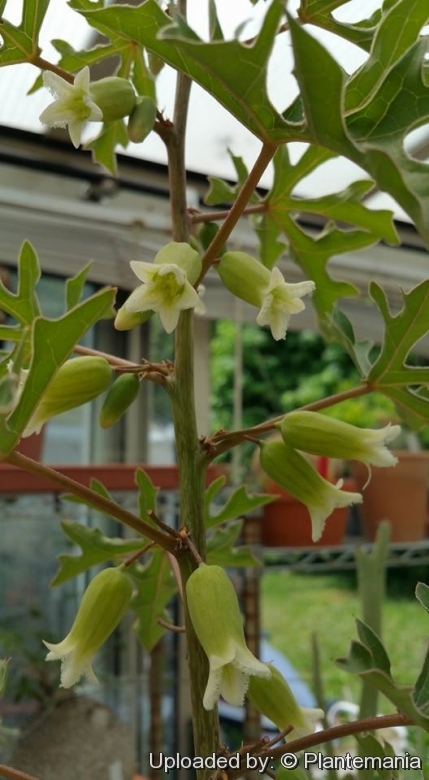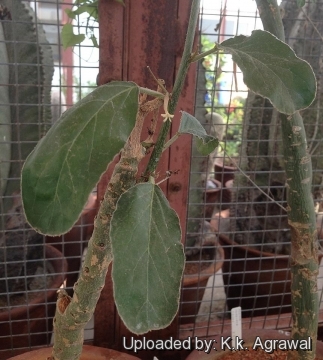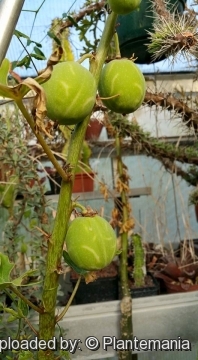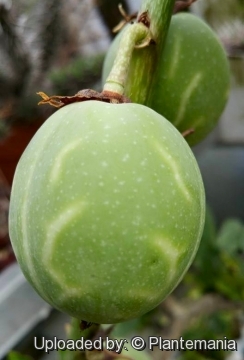




Your support is critical to our success.

Origin and Habitat: Adenia ellenbeckiiSN|29169]]SN|29169]] occurs in Ethiopia, Somalia, Kenya, Uganda and Tanzania.
Altitude range: 30-1050(–1500) metres above sea level.
Habitat and origin: Acacia-Commiphora bushland, rocky places, clayey soils; lava, granite, black cotton soil, red sandy soil or loam.
Synonyms:
- Adenia ellenbeckii Harms
Adenia ellenbeckii Harms
Notizbl. Bot. Gart. Berlin-Dahlem 8: 298 1923
Synonymy: 3
- Adenia ellenbeckii Harms
- Adenia toxicaria Harms
- Adenia vitifolia Hutch. & E.A.Bruce
Description: Adenia ellenbeckii is a monoecious shrub or herb up to about 1,5 m high with climbing or suberect shoots growing from an erect, more or less woody succulent stem arising from a tuberous rootstock. Whole plant usually pubescent, rarely subglabrous.
Stems: Shoots suberect or climbing or prostrate herbaceous 20–150 cm tall, growing from an erect succulent stem up to 30(–60) cm tall, from a tuberous rootstock. Sterile tendrils to 10 cm long, one per leaf or absent.
Leaves: Entire to mostly deeply palmately 3–5(–7)-lobed or pinnatifid, mostly ovate in outline, cuneate to cordate at the base, 2–17 cm long 1.5–11 cm wide, with 3–5 main nerves from the base; margin variously dentate or dissected, pale green, not punctate beneath, mostly pubescent especially on the nerves. Lobes ovate or obovate to oblong, 1–8 cm long, top obtuse to acute. Petiole 1–7 cm long. Glands at base of blade 2, mostly sessile at each side of petiole. Glands on blade often present. Stipules triangular, dark brown dotted, 1–2.5 mm long. Juvenile leaf-forms sometimes have a peltate blade-base.
Inflorescences: Sessile, 1–10-flowered in male plants, 1–3-flowered in female plants, without or with a tendril 2–10 cm long.
Male flowers: Tubular, including stipe 20–50 mm long, 3–6 mm wide. Hypanthium including calyx tube 14–45 mm long; calyx-lobes 3–6 mm long, with woolly fringed edge. Petals lanceolate, 5–8(–11) mm long, fringed, inserted in calyx-tube. Corona absent or consisting of but a few hairs.
Female flowers: Tubular, 12–35 mm long; pistil 4–10 mm long on short gynophore; styles united for 0–4 mm.
Fruit: 1 per inflorescence, subglobose, on short gynophore, 2–4.5(–5) cm in diam, leathery, rather fleshy inside.
Seeds: 10–20 per capsule, ovate, 6.5–8 mm long.
Related species: It is related to Adenia volkensii, but differing by the presence of tendrils, by the inflorescences which are always sessile, and by the narrow flowers in which the corona is lacking or almost lacking.
Bibliography: Major references and further lectures
1) Gaby H. Schmelzer “Plant Resources of Tropical Africa: Medicinal plants” ed.: G. H. Schmelzer ; A. Gurib-Fakim. Assoc. ed.: R. Arroo ... General ed.: R. H. M. J. Lemmens ; L. P. A. Oyen. 11. 1 PROTA, 2008
2) Umberto Quattrocchi “CRC World Dictionary of Medicinal and Poisonous Plants: Common Names, Scientific Names, Eponyms, Synonyms, and Etymology” (5 Volume Set) CRC Press, 03/May/2012
3) M. Thulin “Flora Somalia” Vol 1 1993 [updated by M. Thulin 2008]
4) “Checklist Flow. Pl. Sub-Saharan Africa” 525 2006
5) W. J. J. O. de Wildem (Rijksherbarium, Leiden) “Flora of Tropical East Africa” 1975
6) “Adenia ellenbeckii Harms” in: African Plants Database (version 3.4.0). Conservatoire et Jardin botaniques de la Ville de Genève and South African National Biodiversity Institute, Pretoria, "Retrieved [set month and year]", from <http://www.ville-ge.ch/musinfo/bd/cjb/africa/>.

Adenia ellenbeckii Photo by: © Plantemania

Adenia ellenbeckii Photo by: K.k. Agrawal

Adenia ellenbeckii Photo by: K.k. Agrawal

Adenia ellenbeckii Photo by: © Plantemania

Adenia ellenbeckii Photo by: © Plantemania

Adenia ellenbeckii Photo by: © Plantemania
Cultivation and Propagation: Adenia ellenbeckiiSN|29169]]SN|29169]] is an interesting addition to a collection, but rarely seen in cultivation. It can be grown outdoors in topical climates and forms an impenetrable shrub if not manicured.
Growth rate: It grows well, though very slowly, but it possible to increase the speed of growth to some extent by providing adequate amount of water, warmth, and fertilizer during the active growing season, but it’s susceptible to rotting if too wet.
Exposure: It needs light shade, but the caudex should be in the shade, while the leaves prefer some sun. Avoid direct blasting sun in summer. Bright light if grown indoors.
Soil: In pots it needs a very porous potting medium (add pumice, vulcanite, and perlite). It does better in a rather acidic soil.
Waterings: Water frequently while plant is in full growth, but keep dry during the winter after the branches have died back. It rot easily and do NOT like a lot of water when it has no leaves.
Fertilizer: Benefits from moderate doses of a well-balanced, slow-release fertilizer.
Frost tolerance: Due to its African origin keep warm in winter, the minimum safe average temperature is 15°C, although it can go lower for short periods. It can be grown outdoors in frost-free climates, need anyway to kept above 10°C and dry in winter. It is very prone to rot in cool, wet conditions. USDA Zone 10-12, but does very well in containers.
Manteinance: Repot every two years. It like pots with generous drain holes. In the winter, the vining branches die back and should be cut back t to encourage branching, to maintain an attractive shape and to ensure caudex habit. If pruned and kept somewhat pot bound, it can be maintained at a manageable size, depending on what ''manageable size'' means to you.
Uses: Adenia ellenbeckiiSN|29169]]SN|29169]] is a poisonous plant and has medicinal properties. A decoction of its fruit is taken to treat wounds and fruit powder is applied to the wounds. It contains cytotoxic lectins. The juice of the fruit added to meat is used to poison hyenas. In Ethiopia the leaves are eaten as a vegetable.
Propagation: The species can be propagated by both seeds and cuttings. The plants for seed production are generally grown from cuttings since these bloom more freely. The plants for decoration are grown from seed since they develop a caudex.
Warning: As with all Adenias, all parts of this plant are very toxic, and they should be handled with caution, particularly when pruning.
| Your Actions | |
|---|---|
| Back to Adenia index | |
| Back to Passifloraceae index | |
 |
Back to Succulents Encyclopedia index |
Privacy stantement - Terms and conditions - How to cite - About us - Feedback - Donate



